Optimal Band Analysis of a Space-Based Multispectral Sensor for Urban Air Pollutant Detection
Abstract
:1. Introduction
2. Band Selection Driven by Background and Target Characteristics
- The geographic coordinates of the observed region can be studied at the specific moment, since satellite orbits are generally preset and known;
- The variation of the ground covers is much slower than the variation of the atmospheric condition.
3. Calculation Model for Atmospheric Radiative Transfer Characteristic
3.1. Total Background Radiance
3.2. Impact of Gaseous Molecules
3.3. Impact of Aerosol Particles
4. Analysis on Optimal Band for Pollutant Detection
4.1. Contrast Analysis
4.2. Signal-to-Noise Ratio
5. Results and Discussion
5.1. Gaseous Pollutants
5.1.1. Carbon Monoxide (CO)
5.1.2. Sulfur Dioxide (SO2)
5.1.3. Nitrogen Dioxide (NO2)
5.1.4. Ozone (O3)
5.2. Aerosol Particles
6. Conclusions
Author Contributions
Funding
Conflicts of Interest
References
- Pope, C.A.; Burnett, R.T.; Thun, M.J.; Calle, E.E.; Krewski, D.; Ito, K.; Thurston, G.D. Lung Cancer, Cardiopulmonary Mortality, and Long-term Exposure to Fine Particulate Air Pollution. J. Am. Med. Assoc. 2002, 287, 1132–1141. [Google Scholar] [CrossRef] [PubMed] [Green Version]
- Krewski, D.; Burnett, R.; Goldberg, M.; Hoover, B.K.; Siemiatycki, J.; Jerrett, M.; Abrahamowicz, M.; White, W. Overview of the Reanalysis of the Harvard Six Cities Study and American Cancer Society of Particulate Air Pollution and Mortality. J. Toxicol. Environ. Health Part A 2003, 66, 1507–1551. [Google Scholar] [CrossRef]
- Martin, R.V. Satellite Remote Sensing of Surface Air Quality. Atmos. Environ. 2008, 42, 7823–7843. [Google Scholar] [CrossRef]
- Gu, K.; Qiao, J.; Lin, W. Recurrent Air Quality Predictor Based on Meteorology- and Pollution-Related Factors. IEEE Trans. Ind. Informat. 2018, 14, 3946–3955. [Google Scholar] [CrossRef]
- Jain, R.K.; Moura, M.F.J.; Kontokosta, C.E. Big Data + Big Cities: Graph Signals of Urban Air Pollution. IEEE Signal Process. Mag. 2014, 130, 130–136. [Google Scholar] [CrossRef]
- Shaban, K.B.; Kadri, A.; Rezk, E. Urban Air Pollution Monitoring System with Forecasting Models. IEEE Sens. J. 2016, 16, 2598–2606. [Google Scholar] [CrossRef]
- Kaufman, Y.J.; Tanre, D.; Boucher, O. A Satellite View of Aerosols in the Climate System. Nature 2002, 419, 215–223. [Google Scholar] [CrossRef]
- Wang, J.; Christopher, S.A. Intercomparison between Satellite-derived Aerosol Optical Thickness and PM2.5 Mass: Implications for Air Quality Studies. Geophys. Res. Lett. 2003, 30. [Google Scholar] [CrossRef]
- Donkelaar, A.V.; Martin, R.V.; Park, R.J. Estimating Ground-level PM2.5 Using Aerosol Optical Deth Determined from Satellite Remote Sensing. J. Geophys. Res. 2006, 111. [Google Scholar] [CrossRef]
- Remer, L.A.; Kleidman, R.G.; Levy, R.C.; Kaufman, Y.J.; Tanre, D.; Mattoo, S.; Martins, J.V.; Ichoku, C.; Koren, I.; Yu, H.; et al. Global Aerosol Climatology from the MODIS Satellite Sensors. J. Geophys. Res. 2008, 113. [Google Scholar] [CrossRef]
- Hoff, R.M.; Christopher, S.A. Remote Sensing of Particulate Pollution from Space: Have We Reached the Promised Land? J. Air Waste Manag. Assoc. 2009, 59, 645–675. [Google Scholar] [CrossRef] [PubMed]
- Streets, G.D.; Canty, T.; Carmichael, G.R.; Foy, B.D.; Dickerson, R.R.; Duncan, B.N.; Edwards, D.P.; Haynes, J.A.; Henze, D.K.; Houyoux, M. Emission Estimation from Satellite Retrievals: A Review of Current Capability. Atmos. Environ. 2013, 77, 1011–1042. [Google Scholar] [CrossRef]
- Abad, G.G.; Souri, A.H.; Bak, J.; Chance, K.; Flynn, L.E.; Krotkov, N.A.; Lamsal, L.; Li, C.; Liu, X.; Miller, C.C. Five Decades Observing Earth’s Atmospheric Trace Gases Using Ultraviolet and Visible Backscatter Solar Radiation from Space. J. Quant. Spectrosc. Radiat. Transf. 2019. [Google Scholar] [CrossRef]
- Krueger, A.J. Sighting of El Chichon Sulfur Dioxide Clouds with the Nimbus 7 Total Ozone Mapping Spectrometer. Science 1983, 220, 1377–1379. [Google Scholar] [CrossRef] [PubMed]
- Burrows, J.P.; Weber, M.; Buchwitz, M.; Rozanov, V.; Ladstatter-Werbenmayer, A.; Richter, A.; Debeek, R.; Hoogen, R.; Bramstedt, K.; Eichmann, K.; et al. The Global Ozone Monitoring Experiment (GOME): Mission Concept and First Scientific Results. J. Atmos. Sci. 1999, 56, 151–175. [Google Scholar] [CrossRef]
- Bovensmann, H.; Burrows, J.P.; Buchwitz, M.; Frerick, J.; Noel, S.; Rozanov, V.V.; Chance, K.V.; Goede, A.O.H. SCIAMACHY: Mission Objectives and Measurement Modes. J. Atmos. Sci. 1999, 56, 127–150. [Google Scholar] [CrossRef] [Green Version]
- Buchwitz, M.; Burrows, J.P. Retrieval of CH4, CO, and CO2 Total Column Amounts rom SCIAMACHY Near-infrared Nadir Spectra: Retrieval Algorithm and First Results. Proc. SPIE 2003, 5235, 375–388. [Google Scholar]
- Ahmad, S.P.; Levelt, P.F.; Bhartia, P.K.; Hilsenrath, E.; Leppelmeier, G.W.; Johnson, J.E. Atmospheric Products from the Ozone Monitoring Instrument (OMI). Proc. SPIE 2003, 5151, 619–630. [Google Scholar]
- Veefkind, J.P.; De Haan, J.F.; Brinksma, E.J.; Kroon, M.; Levelt, P.F. Total Ozone from the Ozone Monitoring Instrument (OMI) Using the DOAS Technique. IEEE Trans. Geosci. Remote Sens. 2006, 44, 1239–1244. [Google Scholar] [CrossRef]
- Chance, K.; Liu, X.; Suleiman, M.; Flittner, D.E.; Al-Saddi, J.; Janz, S.J. Tropospheric Emissions: Monitoring of Pollution (TEMPO). Proc. SPIE 2013, 8866, 88660D. [Google Scholar]
- Zoogman, P.; Liu, X.; Suleiman, R.M.; Pennington, W.F.; Flittner, D.E.; Al-Saadi, J.A.; Hilton, B.B.; Nicks, D.K.; Newchurch, M.J.; Carr, J.L. Tropospheric Emissions: Monitoring of Pollution (TEMPO). J. Quant. Spectrosc. Radiat. Transf. 2017, 186, 17–39. [Google Scholar] [CrossRef]
- Ingmann, P.; Veihelmann, B.; Langen, J.; Lamarre, D.; Stark, H.; Courreges-Lacoste, G.B. Requirements for the GMES Atmosphere Service and ESA’s Implementation Concept: Sentinels-4/-5 and -5p. Remote Sens. Environ. 2012, 120, 58–69. [Google Scholar] [CrossRef]
- Choi, W.J.; Moon, K.; Yoon, J.; Cho, A.; Kim, S.; Lee, S.; Ko, D.H.; Kim, J.; Ahn, M.H.; Kim, D. Introducing the geostationary environment monitoring spectrometer. J. Appl. Remote Sens. 2018, 12, 044005. [Google Scholar] [CrossRef]
- Dobber, M.; Kleipool, Q.; Veefkind, P.; Levelt, P.; Rozemeijer, N.; Hoogeveen, R.; Aben, I.; de Vries, J.; Otter, G. From Ozone Monitoring Instrument (OMI) to Tropospheric Monitoring Instrument (TROPOMI). Proc. SPIE 2008, 10566, 105661Z. [Google Scholar]
- Hebestreit, K.; Stutz, J.; Rosen, D.; Matveiv, V.; Peleg, M.; Luria, M.; Platt, U. DOAS Measurements of Tropospheric Bromine Oxide in Mid-Latitudes. Science 1999, 283, 55–57. [Google Scholar] [CrossRef] [PubMed]
- Wagner, T.; Dix, B.; Friedeburg, C.V.; Frieβ, U.; Sanghavi, S.; Sinreich, R.; Platt, U. MAX-DOAS O4 Measurements: A New Technique to Derive Information on Atmospheric Aerosols—Principles and Information Content. J. Geophys. Res. 2004, 109. [Google Scholar] [CrossRef]
- Bhartia, P.K. OMI Algorithm Theoretical Basis Document: Ume II OMI Ozone Products; ATBD-OMI-02, version 2.0; NASA Goddard Space Flight Center: Greenbelt, MD, USA, 2002. Available online: https://eospso.gsfc.nasa.gov/sites/default/files/atbd/ATBD-OMI-02.pdf (accessed on 4 July 2019).
- Krotokov, N.A.; Carn, S.A.; Krueger, A.J.; Bhartia, P.K.; Yang, K. Band Residual Difference Algorithm for Retrieval of SO2 from the Aura Ozone Monitoring Instrument (OMI). IEEE Trans. Geosci. Remote Sens. 2006, 44, 1259–1266. [Google Scholar] [CrossRef]
- Krotkov, N.A.; McClure, B.; Dickerson, R.R.; Cam, S.A.; Li, C.; Bhartia, P.K.; Yang, K.; Krueger, A.J.; Li, Z.; Levelt, P.F. Validation of SO2 Retrievals from the Ozone Monitoring Instrument Over NE China. J. Geophys. Res. 2008, 113. [Google Scholar] [CrossRef]
- Remer, L.A.; Kaufman, Y.J.; Tanre, D.; Mattoo, S.; Chu, D.A.; Martins, J.V.; Li, R.R.; Ichoku, C.; Levy, R.C.; Kleidman, R.G. The MODIS Aerosol Algorithm, Products, and Validation. J. Atmos. Sci. 2005, 62, 947–973. [Google Scholar] [CrossRef] [Green Version]
- Justice, C.O.; Vermote, E.; Townshend, J.R.G.; Defries, R.; Roy, D.P.; Hall, D.K.; Salomonson, V.V.; Privette, J.L.; Riggs, G.; Strahler, A. The Moderate Resolution Imaging Spectroradiometer (MODIS): Land Remote Sensing for Global Chance Research. IEEE Trans. Geosci. Remote Sens. 1998, 36, 1228–1249. [Google Scholar] [CrossRef]
- Pagano, T.S.; Durham, R.M. Moderate Resolution Imaging Spectroradiometer (MODIS). Proc. SPIE 1993, 1939, 2–17. [Google Scholar]
- Liu, Z.; Hunt, W.H.; Young, S.A. Overview of the CALIPSO Mission and CALIOP Data Processing Algorithms. J. Atmos. Ocean. Tech. 2009, 36, 2310–2323. [Google Scholar]
- Jethva, H.; Torres, O.; Remer, L.A.; Bhartia, P.K. A Color Ratio Method for Simultaneous Retrieval of Aerosol and Cloud Optical Thickness of Above-Cloud Absorbing Aerosols from Passive Sensors: Application to MODIS Measurements. IEEE Trans. Geosci. Remote Sens. 2013, 51, 3862–3870. [Google Scholar] [CrossRef]
- Liu, Y.; Park, R.J.; Jacob, D.J.; Li, Q.; Kilaru, V.; Sarnat, J.A. Mapping Annual Mean Ground-level PM2.5 Concentrations Using Multiangle Imaging Spectroradiometer Aerosol Optical Thickness over the Contiguous United States. J. Geophys. Res. 2004, 109, D22206. [Google Scholar]
- Strow, L.L.; De Souza-Machado, S.; Edomonds, Y.; Hannon, S. Quantifying Tropospheric canic Emissions with AIRS: The 2002 Eruption of Mt. Etna (Italy). Geophys. Res. Lett. 2005, 32. [Google Scholar] [CrossRef]
- Teggi, S.; Bogliolo, M.P.; Buongiorno, M.F.; Pugnaghi, S.; Sterni, A. Evaluation of SO2 Emission from Mount Etna Using Diurnal and Nocturnal Multispectral IR and Visible Imaging Spectrometer Thermal IR Remote Sensing Images and Radiative Transfer Models. J. Geophys. Res. 1999, 104, 20069–20079. [Google Scholar] [CrossRef]
- Smith, M.W.; Shertz, S.R.; Delen, N. Remote Sensing of Atmospheric Carbon Monoxide with the MOPITT Airborne Test Radiometer (MATR). Proc. SPIE 1999, 3756, 475–485. [Google Scholar]
- Manolakis, D.; Truslow, E.; Pieper, M.; Cooley, T.; Brueggeman, M. Detection Algorithms in Hyperspectral Imaging Systems: An Overview of Practical Algorithms. IEEE Signal Process. Mag. 2014, 31, 24–33. [Google Scholar] [CrossRef]
- Lopez, S.; Vladimirova, T.; Gonzalez, C.; Resano, J.; Mozos, D.; Plaza, A. The Promise of Reconfigurable Computing for Hyperspectral Imaging Onboard Systems: A Review and Trends. Proc. IEEE 2013, 191, 698–722. [Google Scholar] [CrossRef]
- Bioucas-Dias, J.M.; Plaza, A.; Camps-Valls, G.; Scheunders, P.; Nasrabadi, N.M.; Chanussot, J. Hyperspectral Remote Sensing Data Analysis and Future Challenges. IEEE Geosci. Remote Sens. Mag. 2013, 1, 6–36. [Google Scholar] [CrossRef]
- Lee, Z.; Carder, K.; Arnone, R.; He, M. Determination of Primary Spectral Bands for Remote Sensing of Aquatic Environments. Sensors 2007, 7, 3428–3441. [Google Scholar] [CrossRef] [PubMed] [Green Version]
- Zhu, J.; Liu, W.; Liu, J.; Lu, Y.; Gao, M.; Xu, L.; Zhang, T.; Wei, X. FTIR Measurement and Analysis Based on the Selection of Optimized Spectral band. Spectrosc. Spectr. Anal. 2007, 27, 679–682. [Google Scholar]
- Valor, E.; Caselles, V.; Coll, C.; Rubio, E.; Sospedra, F. NEDT Influence in Thermal Band Selection of Satellite-borne Instruments. Int. J. Remote Sens. 2002, 23, 3493–3504. [Google Scholar] [CrossRef]
- Clodius, W.B.; Weber, P.G.; Borel, C.C.; Smith, B.W. Multi-spectral Band Selection for Satellite-based Systems. Proc. SPIE 1998, 3377, 11–21. [Google Scholar]
- Price, J.C. Spectral Band Selection for Visible-Near Infrared Remote Sensing: Spectral-Spatial Resolution Tradeoffs. IEEE Trans. Geosci. Remote Sens. 1997, 35, 1277–1285. [Google Scholar] [CrossRef]
- Stair, A.T., Jr. MSX Design Parameters Driven by Targets and Backgrounds. J. Hopkins APL Tech. Dig. 1996, 17, 11–18. [Google Scholar]
- Price, J.C. Band Selection Procedure for Multispectral Scanners. Appl. Opt. 1994, 33, 3281–3288. [Google Scholar] [CrossRef]
- Berk, A.; Conforti, P.; Kennett, R.; Perkins, T.; Hawes, F.; van den Bosch, J. MODTRAN 6: A Major Upgrade of the MODTRAN Radiative Transfer Code. Proc. SPIE 1998, 90880H. [Google Scholar] [CrossRef]
- Guanter, L.; Richter, R.; Kaufmann, H. On the Application of the MODTRAN4 Atmospheric Radiative Transfer Code to Optical Remote Sensing. Int. J. Remote Sens. 2009, 30, 1407–1424. [Google Scholar] [CrossRef]
- Clough, S.A.; Shephard, M.W.; Mlawer, E.J.; Delamere, J.S.; Iacono, M.J.; Cady-Pereira, K.; Boukabara, S.; Brown, P.D. Atmospheric Radiative Transfer Modeling: A Summary of the AER Codes. J. Quant. Spectrosc. Radiat. Transf. 2005, 91, 233–244. [Google Scholar] [CrossRef]
- Chen, W.; Xu, X. Spectral Resolution Enhancement for SBDART. IEEE Congr. Image Signal Process. 2008, 5, 523–527. [Google Scholar]
- He, X.; Xu, X. Contrast Analysis of Space-based of Earth Observational Infrared System. Proc. SPIE 2014, 9249, 92490F. [Google Scholar]
- Shi, X.; Xu, X. Impact of Background Radiation on the Detection Performance of Interceptor Seekers. J. Syst. Eng. Electron. 2010, 32, 2053–2056. [Google Scholar]
- He, X.; Xu, X. Physically Based Model for Multispectral Image Simulation of Earth Observation Sensors. IEEE J. Sel. Top. Appl. Earth Obs. Remote Sens. 2017, 10, 1897–1908. [Google Scholar] [CrossRef]
- He, X.; Xu, X. Optimal Band Analysis for Dim Target Detection in Space-variant Sky Background. Proc. SPIE 2018, 10795, 107950N. [Google Scholar]
- Kesbava, N.; Mustard, J.F. Spectral Unmixing. IEEE Signal Process. Mag. 2002, 19, 44–57. [Google Scholar] [CrossRef]
- Bioucas-Dias, J.M.; Plaze, A.; Dobigeon, N.; Parente, M.; Du, Q.; Garder, P.; Chanussot, J. Hyperspectral Unmixing Overview: Geometrical, Statistical, and Spares Regression-Based Approaches. IEEE J. Sel. Top. Appl. Earth Obs. Remote Sens. 2012, 50, 354–379. [Google Scholar] [CrossRef]
- Cooke, B.J.; Lomheim, T.S.; Laubscher, B.E.; Rienstra, J.L.; Clodius, W.B.; Bender, S.C.; Weber, P.G.; Smith, B.W.; Vampola, J.L.; Claassen, P.J. Modeling the MTI Electro-Optic System Sensitivity and Resolution. IEEE Trans. Geosci. Remote Sens. 2005, 43, 1950–1962. [Google Scholar] [CrossRef]
- Curtis, A.R. Discussion of a Statistical Model for Water Vapour Absorption. Q. J. R. Meteorol. Soc. 1952, 78, 638–640. [Google Scholar]
- Godson, W.L. The Evaluation of Infrared-Radiative Fluxes due to Atmospheric Water Vapour. Q. J. R. Meteorol. Soc. 1953, 79, 367–379. [Google Scholar] [CrossRef]
- Thalman, R.; Zarzana, K.; Tolbert, M.A.; Kamer, R. Rayleigh Scattering Cross-section Measurements of Nitrogen, Argon, Oxygen and Air. J. Quant. Spectrosc. Radiat. Transf. 2014, 147, 171–177. [Google Scholar] [CrossRef]
- Gordon, I.E.; Rothman, L.S.; Hill, C.; Kochanov, R.V.; Tan, Y.; Bernath, P.F.; Birk, M.; Boudon, V.; Campargue, A.; Chance, K.V. The HITRAN2016 Molecular Spectroscopic Database. J. Quant. Spectrosc. Radiat. Transf. 2017, 203, 3–69. [Google Scholar] [CrossRef]
- Rothman, L.S.; Pinsland, C.P.; Goldman, A.; Massie, S.T.; Edwards, D.P.; Flaud, J.M.; Perrin, A.; Camy-peyret, C.; Dana, V.; Mandin, J.Y. The HITRAN Molecular Spectroscopic Database and HAWKS (HITRAN Atmospheric Workstation): 1996 Edition. J. Quant. Spectrosc. Radiat. Transf. 1998, 60, 665–710. [Google Scholar] [CrossRef]
- Anderson, G.P.; Chetwynd, J.H.; Clough, S.A.; Shettle, E.P.; Kneizys, F.X. AFGL Atmospheric Constituent Profiles (0–120 km); AFGL-TR-86-0110; Air Force Geophysics Laboratory: Hanscom AFB, MA, USA, 1986. [Google Scholar]
- Wiscombe, W.J. Improved Mie Scattering Algorithms. Appl. Opt. 1980, 19, 1505–1509. [Google Scholar] [CrossRef] [PubMed]
- Shettle, E.P.; Fenn, R.W. Models for the Aerosols of the Lower Atmosphere and the Effects of Humidity Variations on Their Optical Properties; AFGL-TR-79-0214; Air Force Geophysics Laboratory: Hanscom AFB, MA, USA, 1979. [Google Scholar]
- Cao, J.; Wang, Q.; Chow, J.; Watson, J.G.; Tie, X.; Shen, Z.; Wang, P.; An, Z. Impacts of Aerosol Compositions on Visibility Impairment in Xi’an, China. Atmos. Environ. 2012, 59, 559–566. [Google Scholar] [CrossRef]
- Koffi, B.; Schulz, M.; Breon, F.; Dentener, F.; Steensen, B.M.; Griesfeller, J.; Winker, D.; Balkanski, Y.; Bauer, S.E.; Bellouin, N. Evaluation of the Aerosol Vertical Distribution in Global Aerosol Models through Comparison against CALIOP Measurements: AeroCom Phase II Results. J. Geophys. Res. Atmos. 2015, 121, 7254–7283. [Google Scholar] [CrossRef]
- Yamamoto, Y.; Sumizawa, H.; Yamada, H.; Tonokura, K. Real-time Measurement of Nitrogen Dioxide in Vehicle Exhaust Gas by Mid-Infrared Cavity Ring-down Spectroscopy. Appl. Phys. B 2011, 105, 923–931. [Google Scholar] [CrossRef]
- Lightner, K.J.; McMillan, W.W.; McCann, K.J.; Hoff, R.M.; Newchurch, M.J.; Hinsta, E.J.; Barnet, C.D. Detection of a Tropospheric Ozone Anomaly Using a Newly Developed Ozone Retrieval Algorithm for an Up-looking Infrared Interferometer. J. Geophys. Res. 2009, 114, D06304. [Google Scholar] [CrossRef]
- Loveland, T.R.; Reed, B.C.; Brown, J.F.; Ohlen, D.O.; Zhu, Z.; Yang, L.; Merchant, J.W. Development of a Global Land Cover Characteristics Database and IGBP DISCover from 1 km AVHRR Data. Int. J. Remote Sens. 2000, 21, 1303–1330. [Google Scholar] [CrossRef]
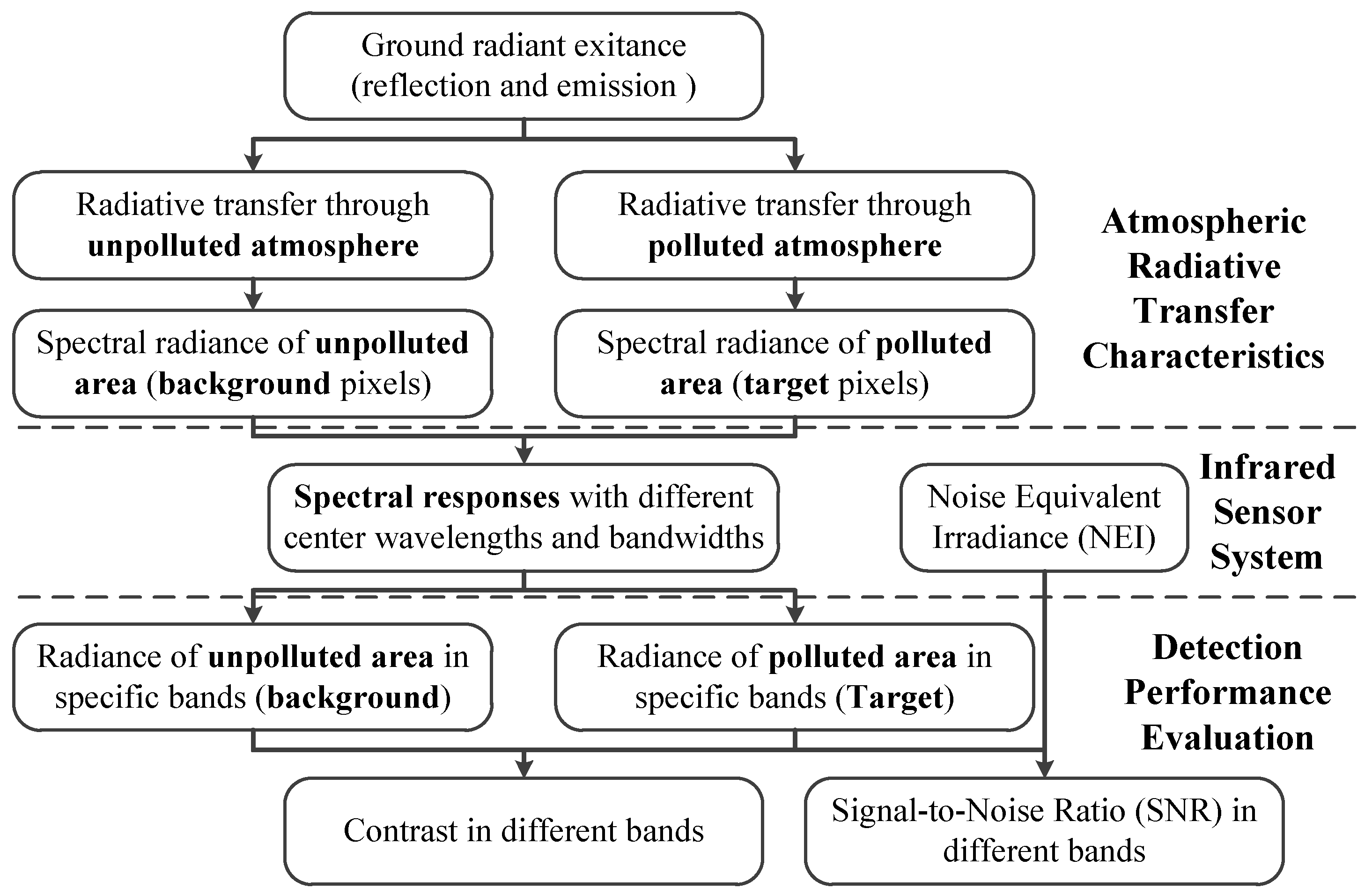
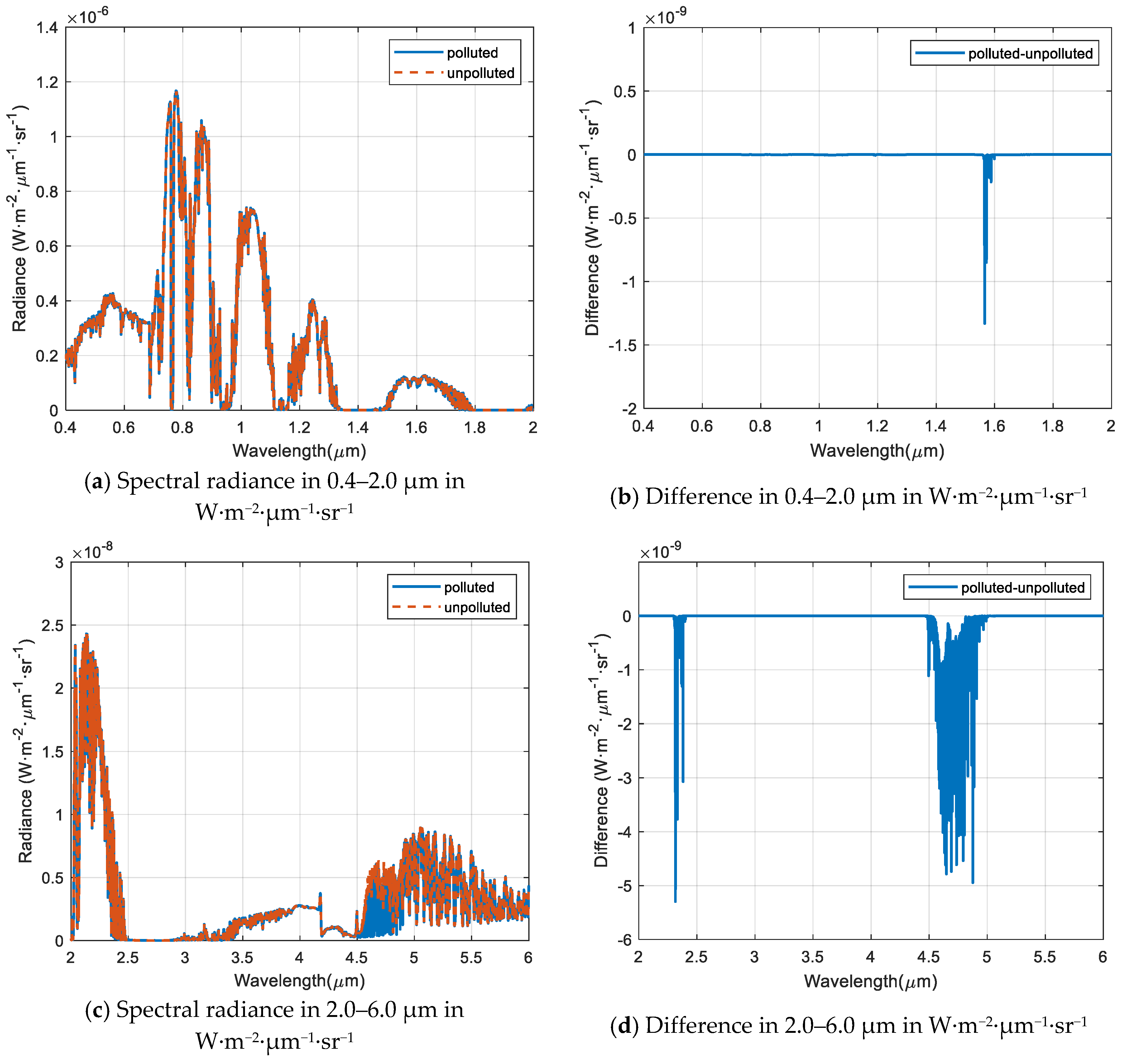
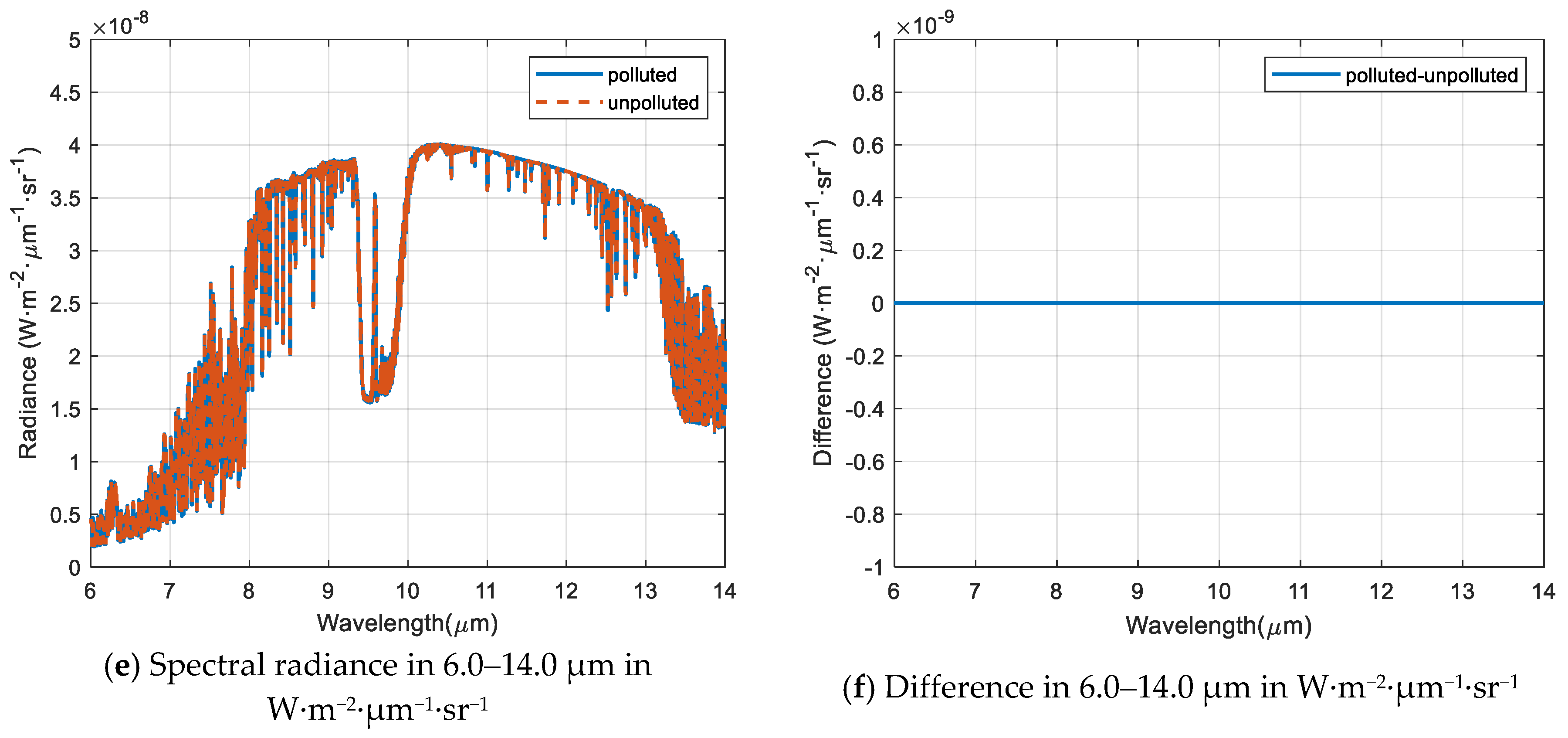
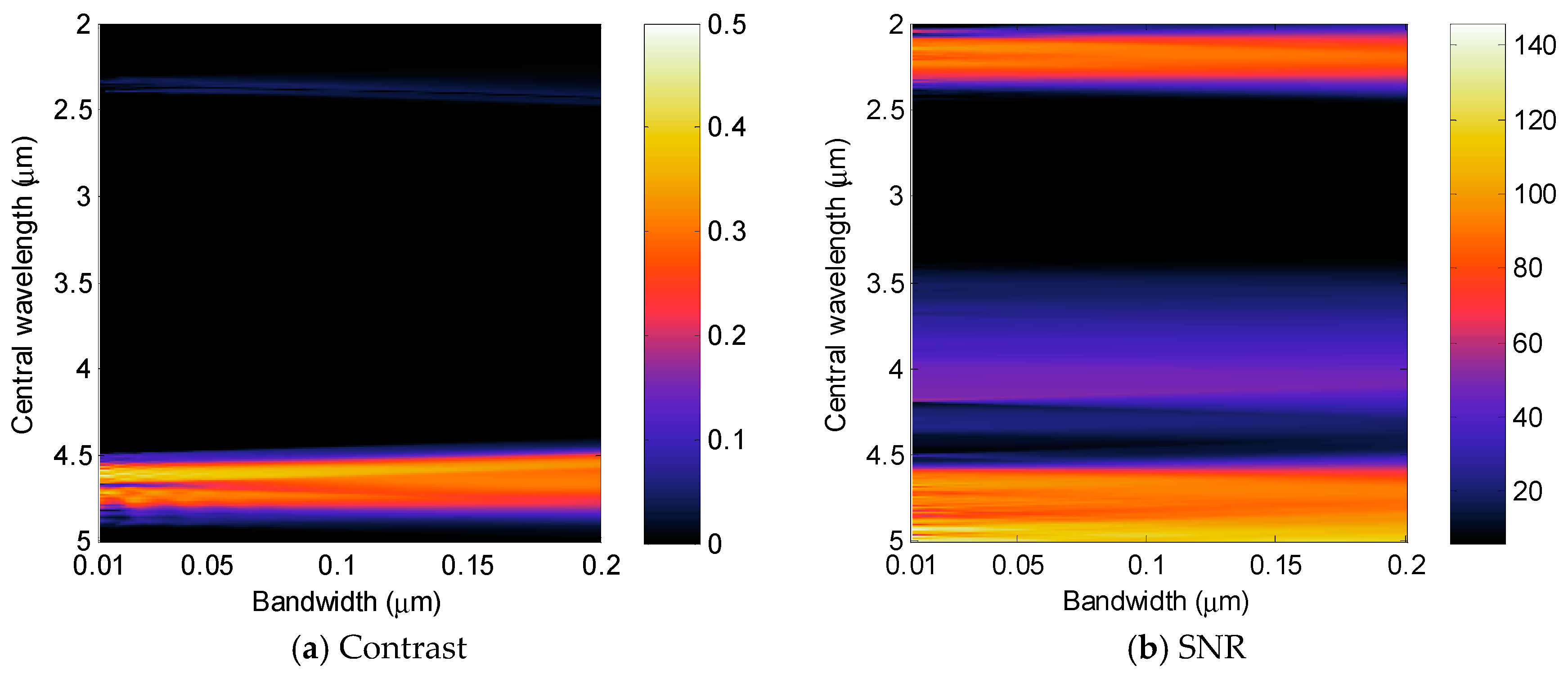
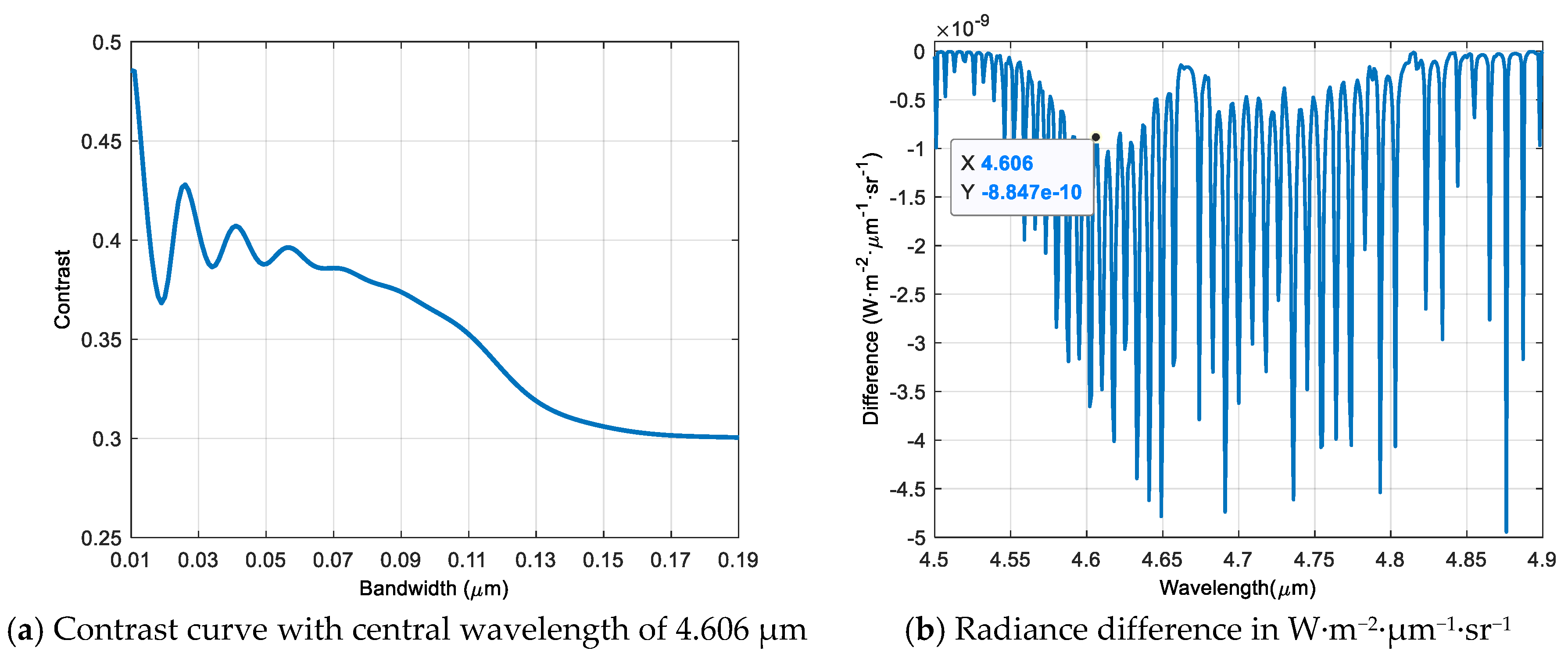
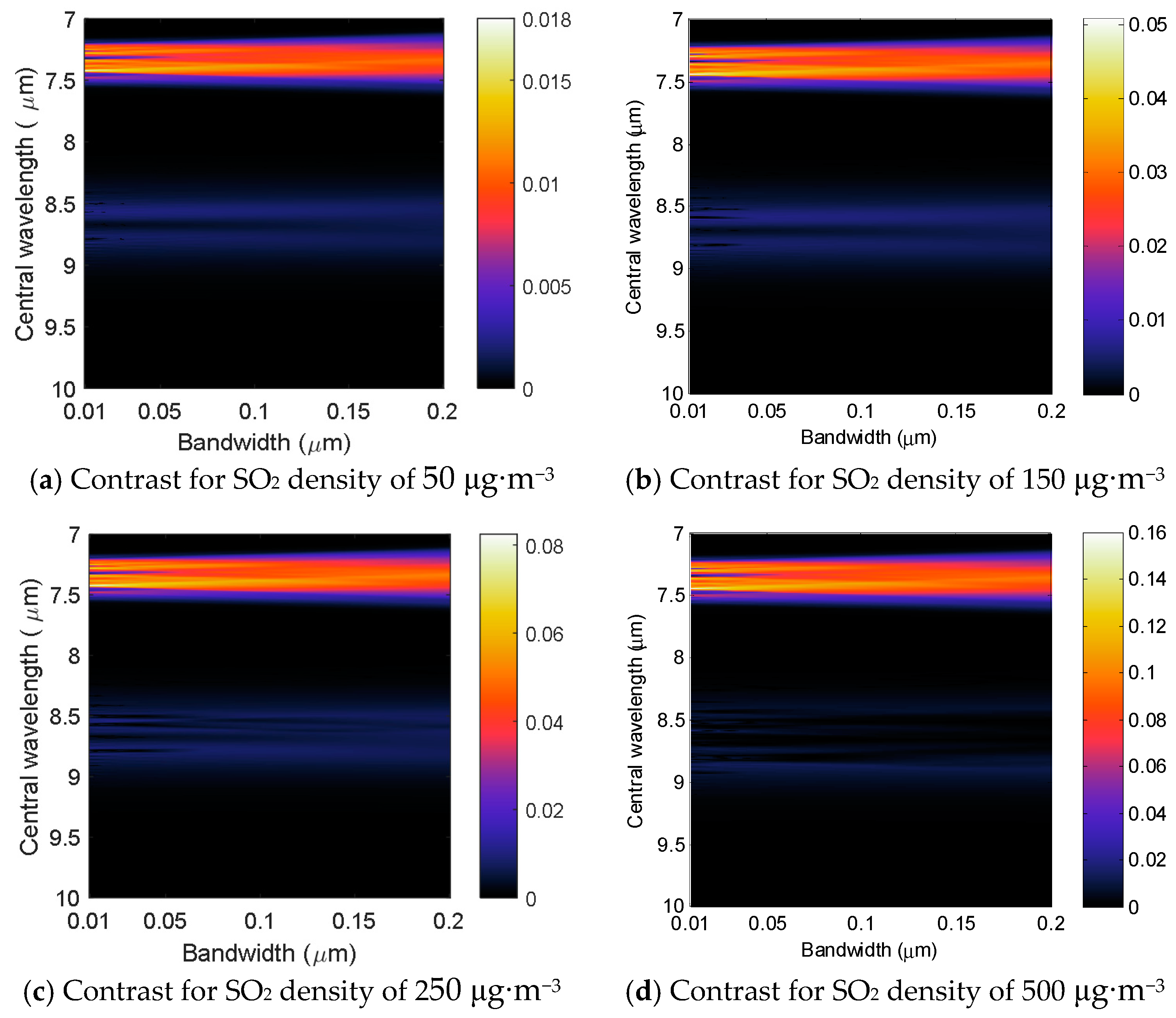
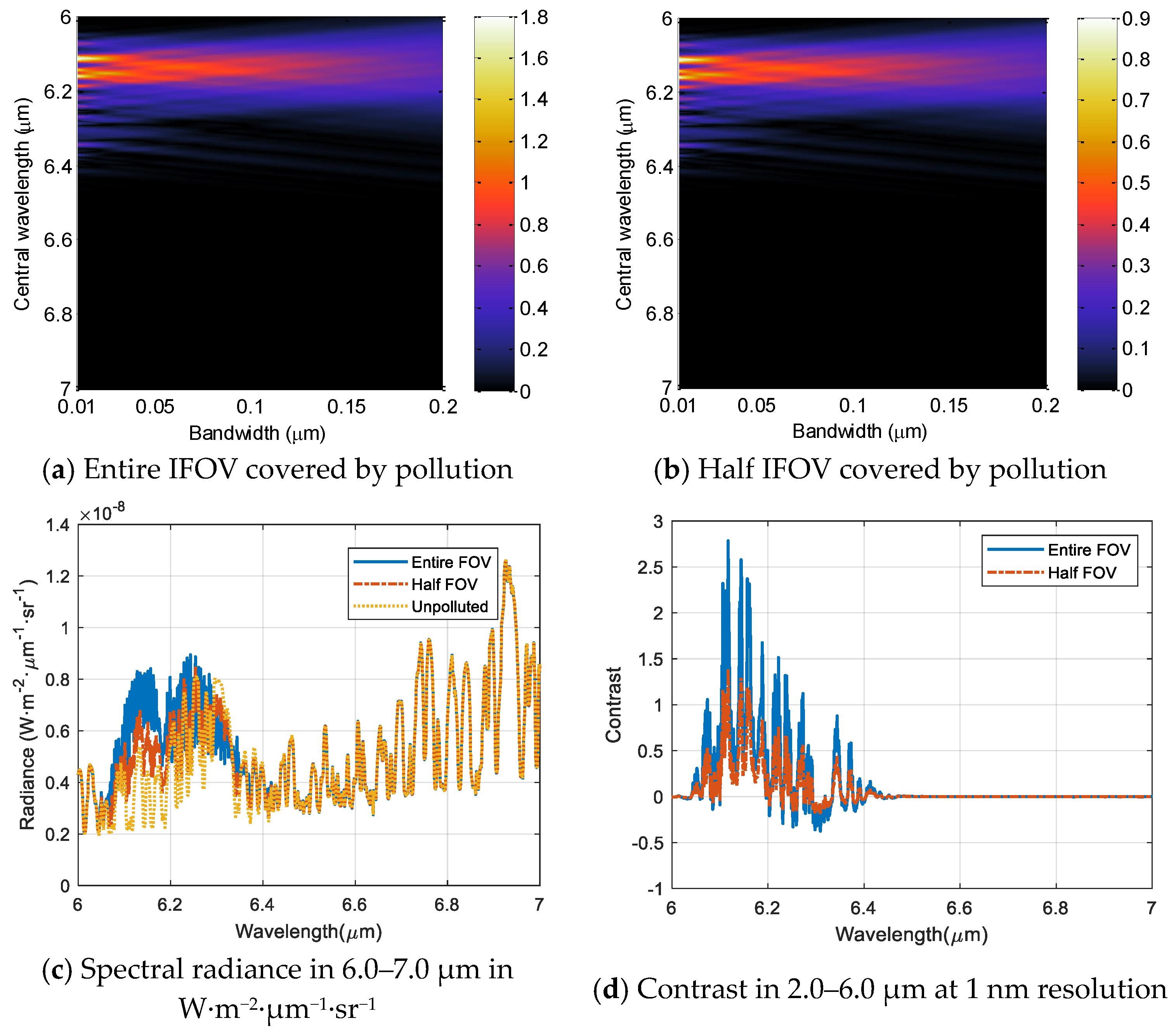

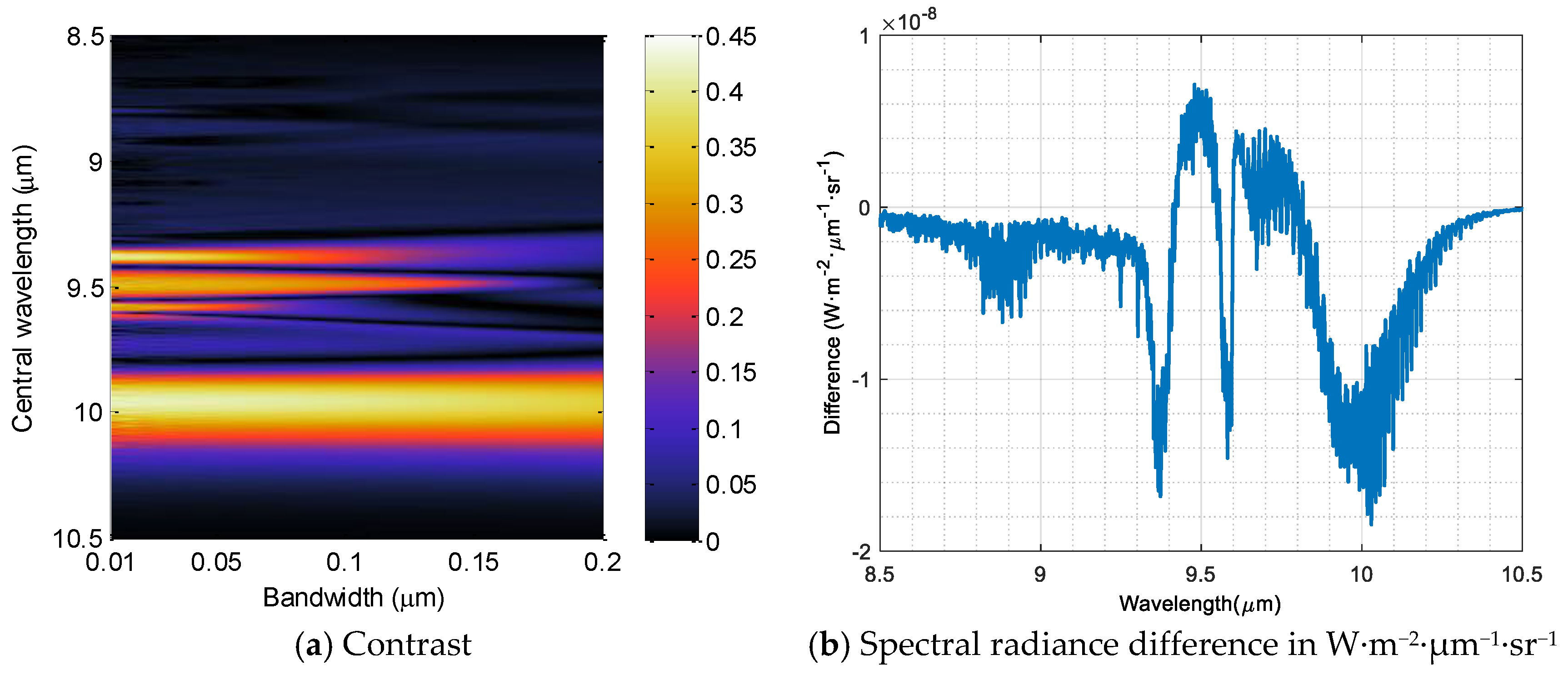
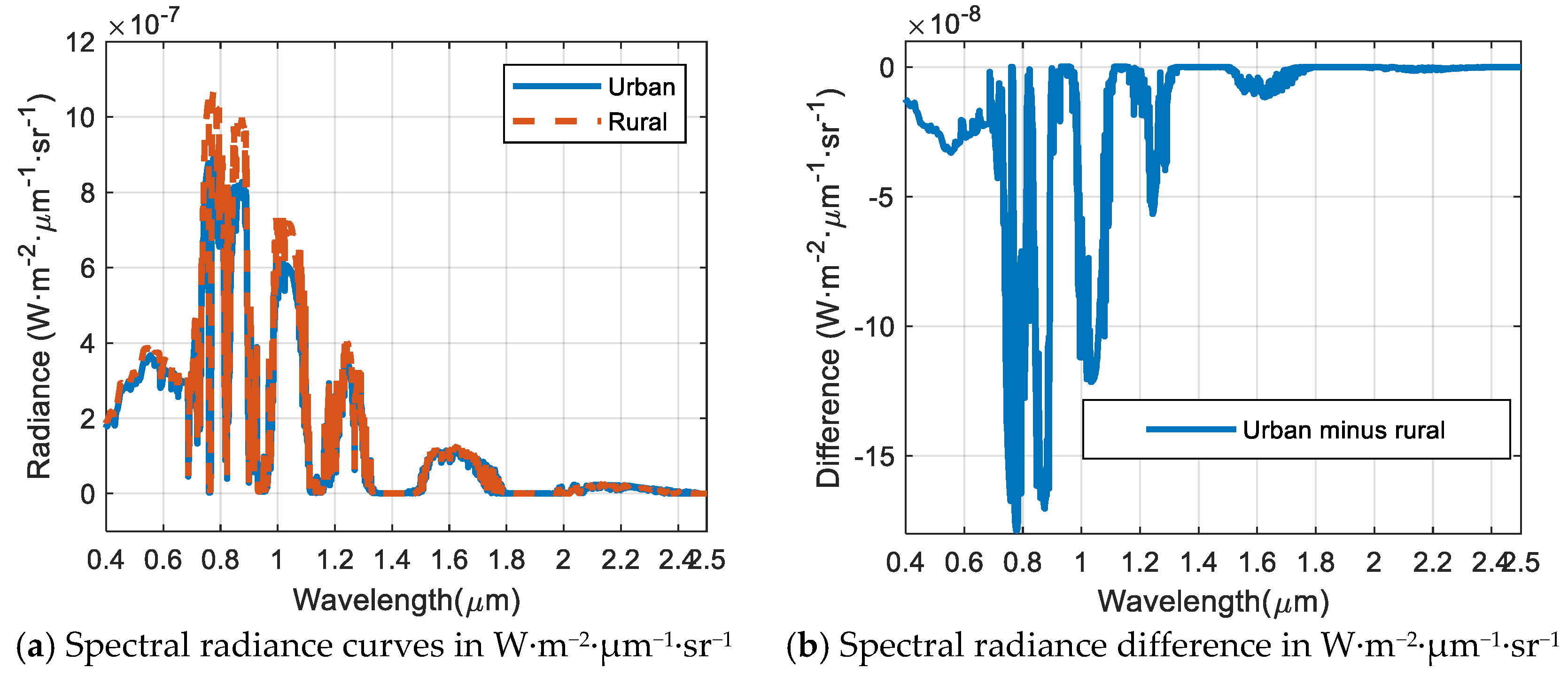
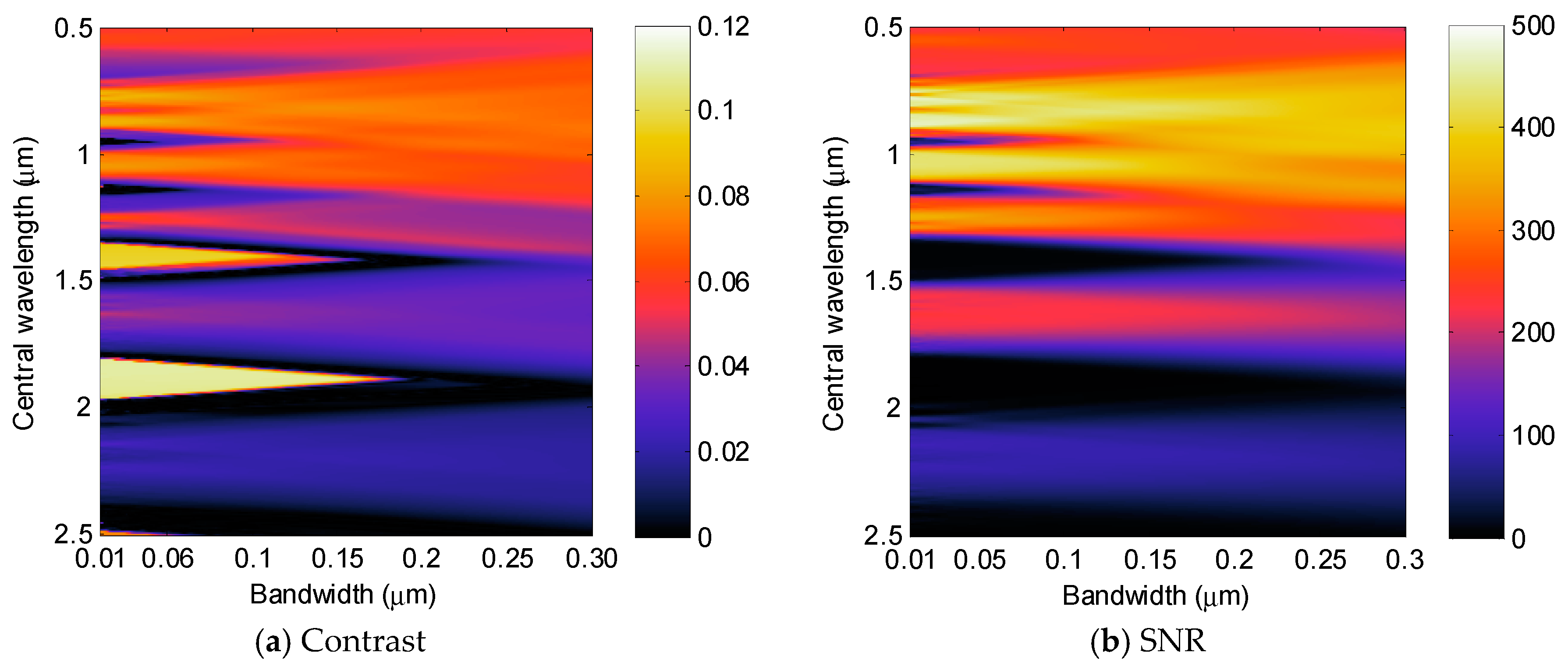
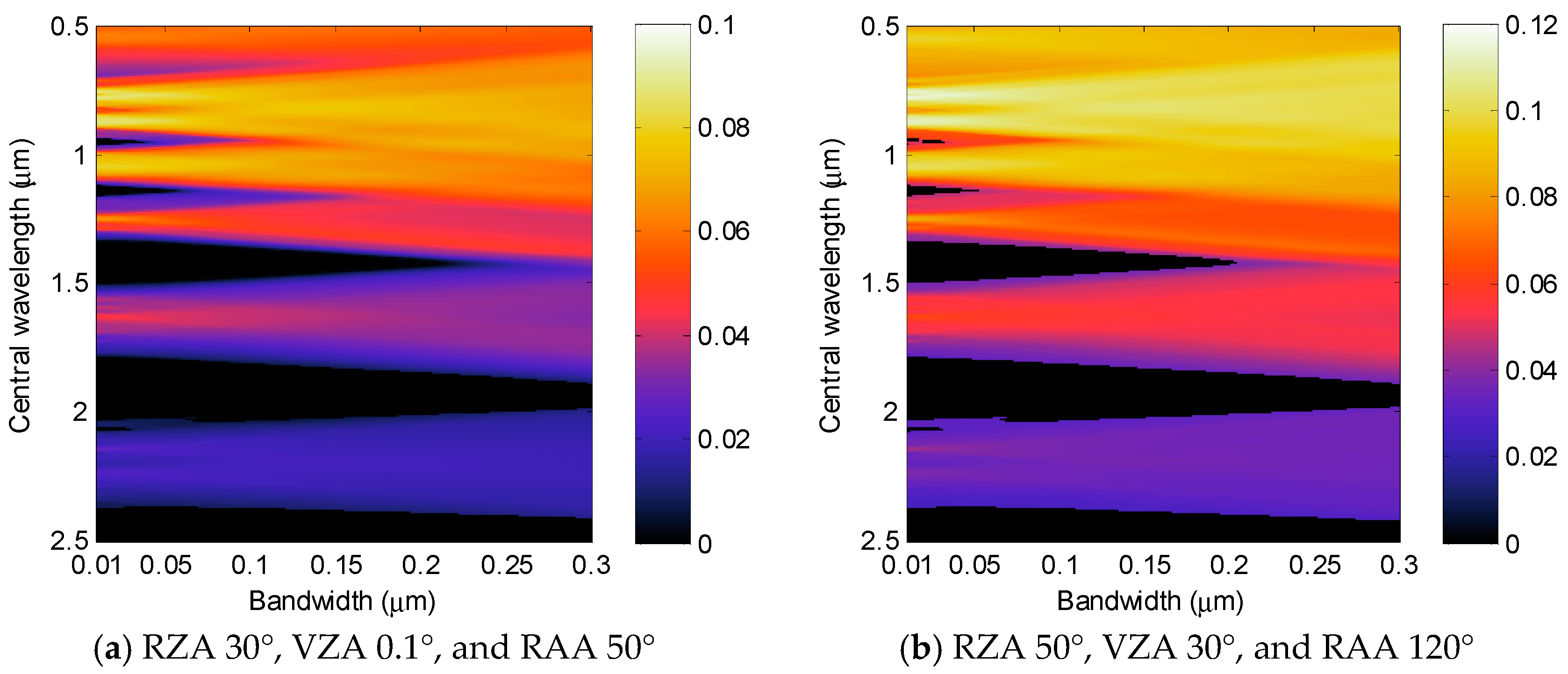
| Description | Value | |
|---|---|---|
| Sensor System | IFOV | 70.896 μrad |
| Detector integration time | 0.5 ms | |
| Effective focal length | 380.86 mm | |
| Effective pupil diameter | 17.78 cm | |
| Temperature of optical train | 99 K | |
| Temperature of shield | 99 K | |
| Temperature of focal plane array | 223 K | |
| Quantization | 12 bits | |
| Voltage of analog-to-digital conversion | 1 V | |
| Description | Value | ||
|---|---|---|---|
| Atmosphere | Atmospheric model | Mid-latitude summer | |
| Boundary Aerosol Type | Rural | ||
| Relative humidity | 90% | ||
| Visibility | 23 km | ||
| Temperature of surface | 290 K | ||
| Geometry | Solar zenith angle | 30° | |
| Viewing zenith angle | 0.1° | ||
| Relative azimuth angle | 50° | ||
| Height of surface | 0.001 km | ||
| Height of sensor | 705 km | ||
| Band selection | Central wavelength of spectral filter | CO [38] | 2.0–5.0 μm in step of 1 nm |
| SO2 [36] | 7.0–10.0 μm in step of 1 nm | ||
| NO2 [70] | 6.0–7.0 μm in step of 1 nm | ||
| O3 [71] | 9.0–10.0 μm in step of 1 nm | ||
| Shape of spectral filter | Blackman Window | ||
| Bandwidth of spectral filter | 0.01–0.2 μm in step of 1 nm | ||
| SNR Threshold (γ) | 6 | ||
© 2019 by the authors. Licensee MDPI, Basel, Switzerland. This article is an open access article distributed under the terms and conditions of the Creative Commons Attribution (CC BY) license (http://creativecommons.org/licenses/by/4.0/).
Share and Cite
He, X.; Xu, X.; Zheng, Z. Optimal Band Analysis of a Space-Based Multispectral Sensor for Urban Air Pollutant Detection. Atmosphere 2019, 10, 631. https://doi.org/10.3390/atmos10100631
He X, Xu X, Zheng Z. Optimal Band Analysis of a Space-Based Multispectral Sensor for Urban Air Pollutant Detection. Atmosphere. 2019; 10(10):631. https://doi.org/10.3390/atmos10100631
Chicago/Turabian StyleHe, Xiaoyu, Xiaojian Xu, and Zheng Zheng. 2019. "Optimal Band Analysis of a Space-Based Multispectral Sensor for Urban Air Pollutant Detection" Atmosphere 10, no. 10: 631. https://doi.org/10.3390/atmos10100631





